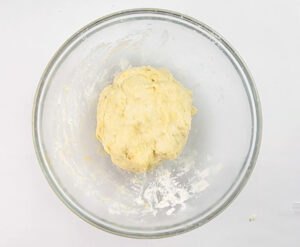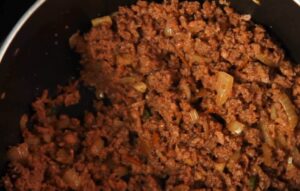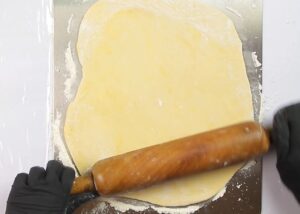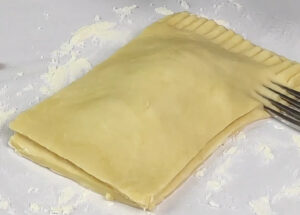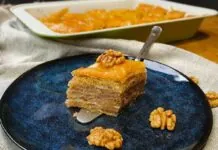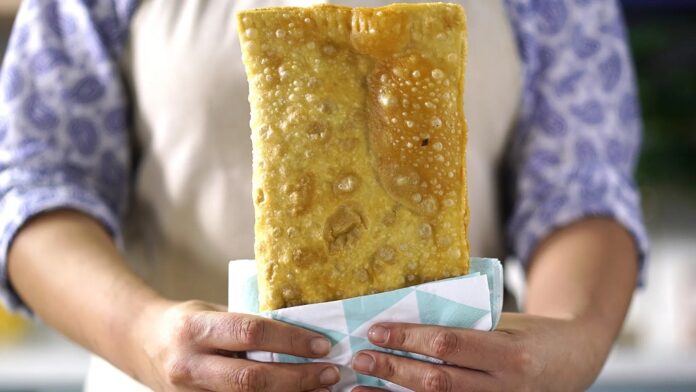
Over the past few weeks, I’ve been experimenting with some of Brazil’s best-known dishes.
Today, it’s time to prepare the authentic Brazilian pastel. It’s an easy yet satisfying recipe that captures the joy of Brazilian street food right in your own kitchen.
Let’s get started!
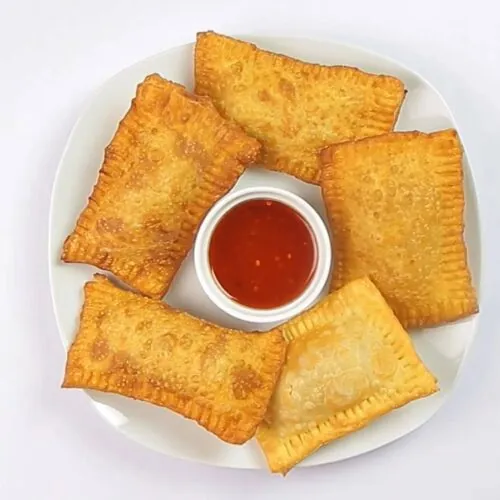
Brazilian Pastel Recipe
Equipment
- 1 Large mixing bowl
- 1 Rolling Pin
- 1 Sharp knife or pizza cutter
- 1 Deep frying pan or deep fryer
- 1 Slotted spoon
- 1 Paper towels
- 1 Fork for sealing
Ingredients
For the Dough:
- 3 Cups All-purpose flour
- 1 Tbsp Vegetable oil
- 1 Tbsp Cachaça (or vodka as a substitute)
- 1 Whole Large egg
- 1 Tsp Salt
- 1 Cup Warm water
For the Fillings
Cheese Filling
- 1½ Cups Shredded mozzarella cheese
Beef Filling
- 1 lb Ground beef cooked and seasoned
- Salt
- Black pepper
- Minced garlic
- Chopped onions
Hearts of Palm Filling
- 1 Can Hearts of palm Chopped
- Cream cheese
- Pinch Salt
Banana & Chocolate Filling
- 2 Ripe Bananas Sliced
- ½ Cup Chocolate chips
For Frying
- Vegetable oil for deep frying
Instructions
- Prepare the Dough:In a large mixing bowl, combine flour and salt. Make a well in the center and add vegetable oil, cachaça, and egg.Gradually add warm water, mixing until a rough dough forms. Knead on a lightly floured surface for 5-7 minutes until smooth and elastic.Cover with plastic wrap and let rest for 20 minutes.
- Prepare the Fillings:Beef: Ensure the beef is fully cooked and seasoned. Set aside to cool.Cheese: Have the shredded mozzarella ready.Hearts of Palm: Mix chopped hearts of palm with cream cheese and adjust salt as needed.Banana & Chocolate: Slice bananas and have chocolate chips ready.
- Roll Out the Dough:Divide dough into small portions and roll each out on a floured surface until thin (about 1/16 inch thick).Cut the dough into rectangles, about 4×6 inches.
- Fill the Pastel:Place about 1-2 tablespoons of your chosen filling in the center of each dough rectangle, avoiding overfilling.Fold the dough over to enclose the filling, forming a rectangle or triangle. Press edges with a fork to seal, ensuring no filling is exposed.
- Fry the Pastel:Heat vegetable oil in a deep frying pan to 350°F (175°C).Carefully place a few pastéis in the hot oil at a time, frying until golden brown, about 2-3 minutes per side.Remove with a slotted spoon and drain on paper towels.
- Serve:Serve hot, with a side of hot sauce or a lime wedge for added flavor.
Video
Notes
- Dough Consistency: The cachaça or vodka makes the crust extra crispy by evaporating quickly during frying. If you don’t have either, omit it, but the crust may be slightly less crispy.
- Filling Variations: Try other popular fillings like cheese with guava paste or ham and cheese for more Brazilian flavors.
- Sealing the Dough: Make sure the edges are well-sealed to prevent filling from leaking during frying.
Different Types of Pastel Fillings
One of the best things about pastel is the sheer variety of fillings you can experiment with. Here are some popular options:
- Cheese Pastel (Pastel de Queijo): The gooey, melty mozzarella filling is a crowd favorite. You can also use a mix of cheeses like provolone or add a touch of oregano for extra flavor.
- Beef Pastel (Pastel de Carne): A savory filling made with seasoned ground beef, often mixed with green olives, boiled eggs, and onions for a burst of flavor.
- Hearts of Palm (Palmito): A creamy and slightly tangy filling made from hearts of palm, perfect for vegetarians.
- Shrimp Pastel (Pastel de Camarão): Fresh shrimp cooked in a tomato and garlic sauce for a seafood twist.
- Sweet Options: Don’t forget dessert pastéis! Fill them with bananas and chocolate, guava paste and cheese (Romeo and Juliet), or even sweet condensed milk for a decadent treat.
Tips for Making Perfect Pastel at Home
- Use Fresh Oil for Frying: To get the best texture and flavor, make sure to use clean, fresh oil for frying. It ensures that your pastel will turn out crispy and free from any stale or bitter aftertaste.
- Keep the Dough Thin: Rolling the dough very thin is key to getting a light and crispy crust. If the dough is too thick, your pastel will be heavy and doughy.
- Seal the Edges Well: Use a fork to crimp the edges tightly and make sure there are no air pockets around the filling. This prevents any oil from seeping in and keeps the filling from leaking out.
- Work Quickly: The dough dries out if left exposed for too long. Keep any dough you aren’t working with covered to ensure it remains pliable and easy to handle.
How to Serve Brazilian Pastel?
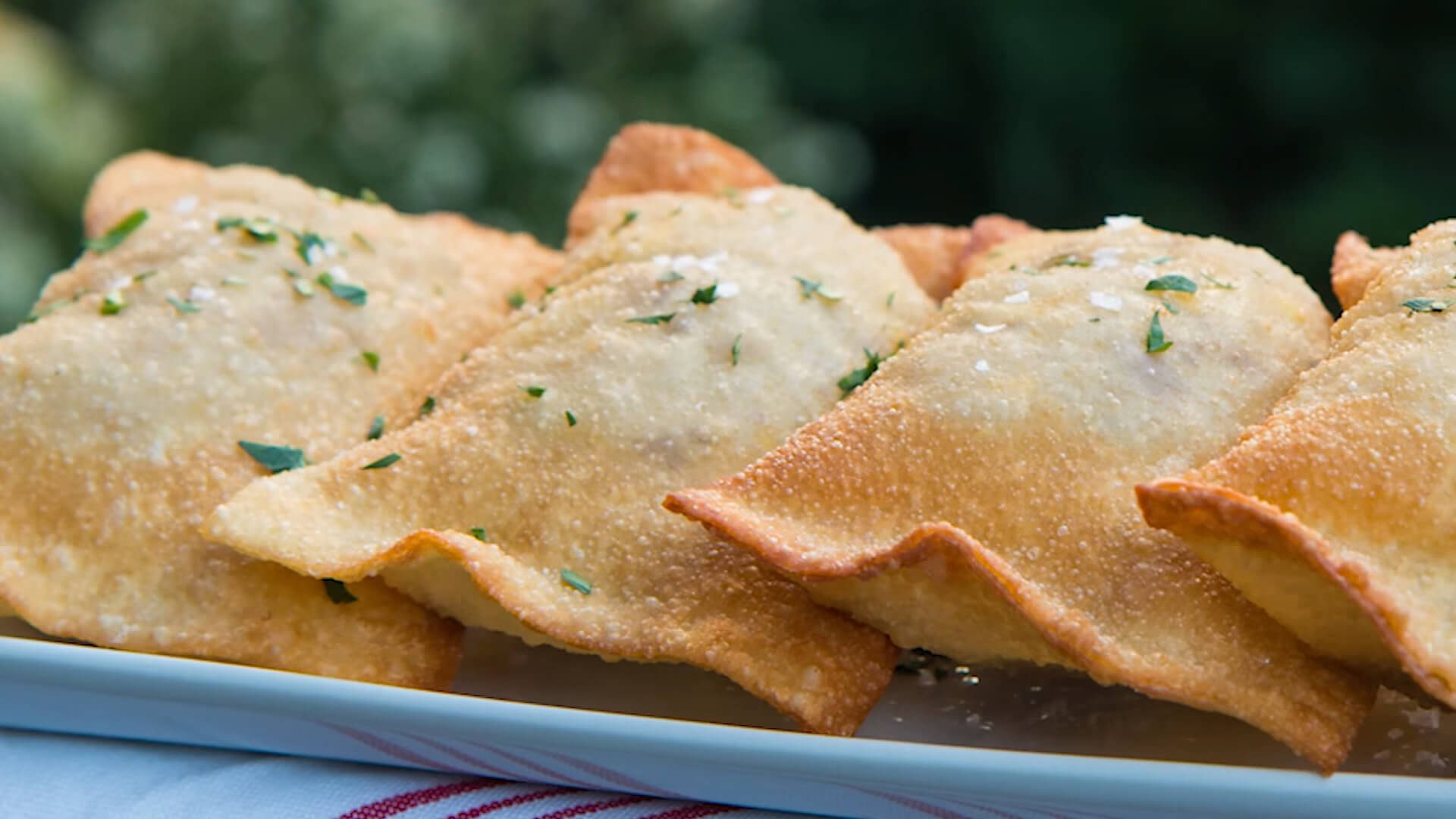
Pastel is best enjoyed fresh out of the fryer, when it’s at its crispiest. Serve them with a dipping sauce like vinagrete (a Brazilian salsa made with chopped tomatoes, onions, and bell peppers marinated in vinegar and olive oil) or a spicy chili sauce. If you want to go all out, pair your pastel with a traditional Brazilian drink like caldo de cana (fresh sugarcane juice) or a glass of ice-cold guaraná soda.
Pastel also makes a fantastic addition to a spread of other Brazilian favorites. Consider serving it alongside grilled meats (like picanha) and a side of farofa (toasted cassava flour) to create a full-on Brazilian feast.
Common Mistakes to Avoid
- Overfilling the Pastel: It might be tempting to add more filling, but too much can make it difficult to seal the dough properly, causing leaks and a mess in the frying oil.
- Frying at the Wrong Temperature: If the oil is too hot, the pastel will brown too quickly on the outside and remain undercooked inside. If it’s too cool, the dough will absorb oil and turn out greasy. Use a thermometer to maintain a temperature of around 350°F (175°C).
- Skipping the Rest Time for Dough: Letting the dough rest is crucial as it allows the gluten to relax, making it easier to roll out and giving the crust a tender texture.
Final Thoughts
Making authentic Brazilian pastel at home is not just about frying up a delicious snack—it’s an adventure into the heart of Brazil’s vibrant street food culture. Whether you choose savory fillings like seasoned beef or melting cheese, or go for sweet delights like banana and chocolate, each pastel carries a piece of the country’s rich culinary heritage.
Don’t worry if your first batch isn’t perfect—cooking is about having fun and experimenting! The key is to embrace the process, enjoy the amazing aroma that fills your kitchen, and share the experience with friends or family. Food, especially street food like pastel, is meant to be enjoyed in good company, just like you’d find at a market in Brazil.
So, gather your favorite people, whip up a batch of pastéis, and savor this crispy, golden taste of Brazil. And remember, the best part of cooking is the joy it brings—both to those who make it and those who share it. Enjoy every bite, and perhaps it will inspire you to explore even more of Brazil’s incredible flavors. Happy cooking!

